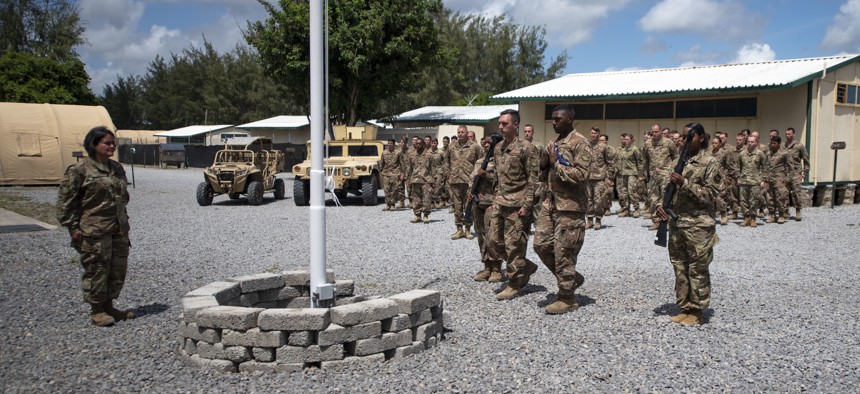
In this photo taken Aug. 26, 2019 and released by the U.S. Air Force, airmen from the 475th Expeditionary Air Base Squadron conduct a flag-raising ceremony, signifying the change from tactical to enduring operations, at Camp Simba, Manda Bay, Kenya. Staff Sgt. Lexie West/U.S. Air Force via AP
Kenya Base ‘Surprisingly’ Undefended During Attack, US Officials Say
The Jan. 5. attack by al-Shabaab killed three Americans came as the Pentagon considers a further drawdown of its African presence.
When al-Shabaab attacked a U.S.-used airfield in Kenya, the al Qaeda affiliate took advantage of a woefully undefended perimeter that allowed its fighters to overrun American and Kenyan forces, according to U.S. and military officials familiar with the details of the Jan. 5 attack that killed a U.S. soldier and two U.S. contractors.
The incident lays bare one of the fundamental challenges of the U.S. military’s counterterrorism missions across the sprawling African continent. Roughly 6,000 U.S. troops and defense civilians are responsible for the entire U.S. mission in Africa — with roughly the same number of troops that are stationed in Iraq alone. By June, the Trump administration plans to finish trimming the U.S. presence by "fewer than 130" special operators, officials said last year.
But the attack comes as the Pentagon is considering further reductions to focus on competition or possible conflict with Russia and China.
Before the attack, Camp Simba and the nearby airfield were seen as a sleepy backwater outpost, according to one military official. The U.S. military is in Kenya training and assisting the local military in the fight against al-Shabaab; Camp Simba is used as a base for American surveillance assets and commandos working with the Kenyans in the porous border region between Somalia and Kenya. “It’s very relaxed, it’s very pretty,” the military official said.
There’s not much to see at the airfield — a few buildings, tents and CONEX shipping containers surrounded by thick jungle vegetation. Baboons occasionally wander onto the airstrip. Waterbucks and lions live in the area. Not far away are resorts visited by celebrities like Angela Jolie and Brad Pitt.
Related: AFRICOM Commander: SpecOps Cuts Won’t Help China, But We Could Use More Regular Troops
Related: Africa, Great Power Competition, and the US Navy
Related: The US Needs a Real Plan to Counter China in Africa
Despite the obvious vulnerabilities of a rural, densely-jungled base so close to the Somali border — and recent warnings that al-Shabaab was increasingly targeting Americans — officials familiar with the attack say the airfield perimeter wasn’t adequately secured to prevent the kind of penetrating attack that killed the three Americans.
Security “was surprisingly sparse,” one military official said. “It’s such thick vegetation and such a large area, it wasn’t properly manned or equipped.”
Camp Simba itself — the residential compound about a mile north of the airfield, where U.S. troops sleep — is well-cleared, said a congressional source with expertise on military operations in the region. “But when I look at the airfield, it’s notable to me the vegetation isn’t cleared around the airstrip,” the source said. Fencing, if there is any, isn’t substantial enough to be visible from satellite imagery.
“This is a no-brainer that it would have been very easy for these guys to sneak up through the brush and get very close to the hangers before they were spotted,” that person said.
A spokesman for U.S. Africa Command, Col. Chris Karns, said in an email Wednesday that the outpost’s security is being evaluated as part of an investigation into the attack.
“Adjustments have already been made based on initial assessment by the general officers who immediately visited the area and the investigation team,” Karns said. “It is important to note, Camp Simba is where the majority of U.S. presence can be found, and after the initial attack a rapid counter-attack occurred.”
How the attack went down
The attack began in the dark hours of the morning, with Shabaab firing mortars on Camp Simba and simultaneously pushing deep into the airfield. The fighters blasted rockets into a taxiing surveillance plane, killing the two American contractors, and destroyed millions of dollars worth of U.S. aircraft and equipment, the New York Times reported. Army Specialist Henry Mayfield Jr., 23, was killed in the ensuing gunfight. A Marine special operations team scrambled from Camp Simba to counter the assault alongside some of the Kenyan Rangers they had been training, but the base is a mile away from the airfield, and many of the Shabaab fighters melted into the night and back across the border into Somalia. Karns said five fighters were killed, while an estimated “several dozen” were driven off.
There are fewer than 350 U.S. troops in all of Kenya, meaning that the Americans relied heavily on the Kenyan military for security. “I haven’t heard anything to very clearly indicate that they [Shabaab] had help from the inside,” the congressional source said.
But questions have swirled about the degree to which the Kenyan forces were responsible for allowing the attackers to get as far as they did. Analysts say the Kenyan forces lack the professionalism and capability of their American trainers, and rumors have circulated Washington — bolstered by the Times report — that the local Kenyan forces assigned to defend the base hid in the grass during the initial attack.
Karns and other Pentagon officials have emphasized that Kenya remains “a very important partner…committed to countering al-Shabaab.”
But that the American forces at the airfield were caught completely by surprise by the ambush still shocked intelligence officials, congressional offices and other regional experts familiar with the region. Despite the idyllic seaside location, Camp Simba is just 50 miles from the Somali border, in an area where al Shabaab is known to operate. The group has attacked civilian targets in Kenya for years: It attacked the Dusit D2 hotel in Nairobi in January 2019, killing 21 people, and Garissa University in eastern Kenya in 2015, killing 148 people.
In recent months, the al Qaeda affiliate has turned its sights on American military targets. On Sept. 30, a suicide bomber exploded a car bomb at the gate of a military airfield in Bale Dogle, in southern Somalia, sparking a fierce firefight between U.S. troops and Shabaab fighters. A U.S. service member was injured.
And on Nov. 5, just months before the Camp Simba attack, al-Shabaab leader Ahmed Omar Abu Ubeyda released a video on social media calling for attacks on Americans wherever they are, including the U.S. public.
Shabaab has proved itself adept in recent years at recruiting Kenyans to its cause, according to analysts — not only from coastal Muslim communities, but also from Kikuyu communities. (The Kikuyu are the largest ethnic group in Kenya.)
“We certainly believe [the Camp Simba attack] came from cross-border,” Maj. Gen. William Gayler, the director of operations at U.S. Africa Command, told reporters recently. “But we equally believe it had to have some kind of component inside of Kenya as well, which stands to be logical.”
The fight against Shabaab — and questions on the Hill
U.S. troops have been fighting Shabaab in Somalia for close to a decade, mostly through aerial attacks. In 2019, two years after President Donald Trump loosened the U.S. rules of engagement to allow for more aggressive action against the group, the military carried out a record 63 airstrikes against Shabaab targets.
“The fact that Shabaab conducted this attack didn’t surprise me in the least,” the congressional source said, calling the threat from Shabaab “persistent and arguably growing.” The group “sees this facility as part of the U.S. airstrike campaign. Even if they’re not conducting flights from here, this is where the [surveillance] flights are for the southern part of the country, is the presumption—it’s a logical follow-on to the attack on the Bale Dogle airfield.”
The question of how, in that environment, perimeter security was so lax, has already drawn scrutiny on Capitol Hill. Rep. Ruben Gallego, D-Ariz., a former Marine, has requested a briefing from the Pentagon on the issue of base protection.
Meanwhile, the idea of drawing down U.S. Africa Command’s area of operations has met stiff opposition from both parties on the Hill, who warn that it would cede influence to Russia and China and allow terror groups to grow.
"Any drawdown of our troops would be short-sighted, could cripple AFRICOM’s ability to execute its mission and, as a result, would harm national security,” Sen. Jim Inhofe, R-Okla., said in a recent speech on the Senate floor.
“A withdrawal from the continent would also certainly embolden both Russia and China,” wrote Sens. Lindsey Graham, R-S.C. and Chris Coons, D-Del., in a letter to Defense Secretary Mark Esper protesting the proposed drawdown.
The drawdown is reported to focus on West Africa, where several hundred American troops are deployed in Niger, Chad and Mali fighting extremist groups like Boko Haram and ISIS-West Africa. But reports in the past year have also suggested that the American mission in Somalia could also be on the cutting board as President Trump, long ambivalent about U.S. counterterrorism missions overseas, continues to raise questions about their utility.
The scrutiny on the Hill is likely to grow, as the Senate’s impeachment trial appears to be winding down. The attack was the single most deadly attack on American forces since an Islamic State ambush in Niger in 2017 killed four American soldiers. That incident surprised lawmakers who claimed not to know that the military was carrying out operations in West Africa, and sparked years of congressional scrutiny.
“Perimeter security is the key question,” the congressional source said. “‘Do we need that many people there?’ is going to be the question that’s asked. The flip side of that question is, ‘do we need more people? If the [surveillance capabilities] and crisis response [from Camp Simba] are important enough to have the forces up there, do we need more force protection up there?’”
AFRICOM commander Gen. Stephen Townsend is set to testify before the Senate Armed Services Committee on Thursday.




